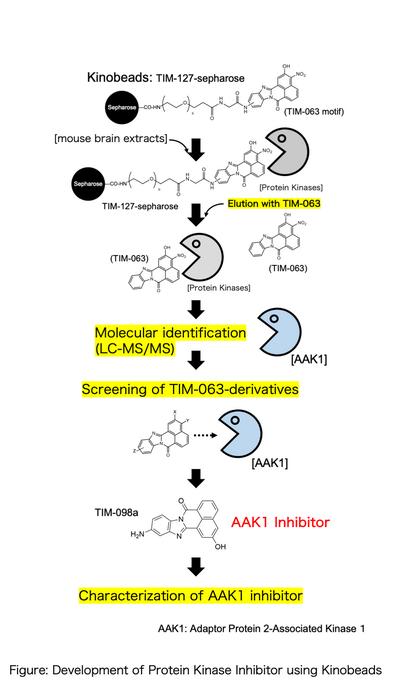Enhancing drug development for life-threatening diseases like cancer hinges on a deep understanding of protein kinases, making it a focal point for researchers. These enzymes, encoded by more than 500 human genes, serve as critical players in cellular signaling pathways. However, if these signals are dysregulated, they can disrupt the normal cellular mechanisms, leading to diseases such as cancer. Protein kinase inhibitors have therefore provided a promising avenue in therapeutic intervention to disrupt the aberrant signaling mechanisms underlying such diseases.

Credit: Hiroshi Tokumitsu from Okayama University
Enhancing drug development for life-threatening diseases like cancer hinges on a deep understanding of protein kinases, making it a focal point for researchers. These enzymes, encoded by more than 500 human genes, serve as critical players in cellular signaling pathways. However, if these signals are dysregulated, they can disrupt the normal cellular mechanisms, leading to diseases such as cancer. Protein kinase inhibitors have therefore provided a promising avenue in therapeutic intervention to disrupt the aberrant signaling mechanisms underlying such diseases.
Due to the similarity and complexity of kinase structures, the development of effective kinase inhibitors has so far presented a formidable challenge for the researchers. Finding specific inhibitors among various potential targets has been a hurdle, until now. A team led by Professor Hiroshi Tokumitsu from the Graduate School of Interdisciplinary Science and Engineering in Health Systems at Okayama University, along with a graduate student Ms. Akari Yoshida and Dr. Satomi Ohtsuka from Okayama University with Professor Ulf J. Nilsson from Lund University and Professor Teruhiko Ishikawa from the Graduate School of Education at Okayama University, published a study in Scientific Reports on 20 March 2024. The study sheds light on a novel inhibitor targeting Adaptor Protein 2-Associated Protein Kinase 1 (AAK1).
Talking about the inspiration, Prof. Tokumitsu states, “Through years of dedicated research into intracellular signaling mechanisms, we’ve crafted protein kinase inhibitors as potent analytical instruments for fundamental life sciences.” And now it was time to see their achievements in action.
Their study introduced an innovative method utilizing Kinobeads technology. This cutting-edge approach enabled the team to explore the interactions between TIM-063, originally formulated as a Ca2+/calmodulin-dependent protein kinase kinase (CaMKK) inhibitor, and numerous protein kinases, with a particular focus on AAK1. Through immobilization onto sepharose beads, TIM-063-sepharose complexes were created to capture target kinases from cellular extracts selectively. After extensive washing to remove nonspecific proteins, bound kinases were eluted and identified through mass spectrometry. This meticulous approach shed light on TIM-063’s binding to AAK1’s catalytic domain, offering insights into its inhibitory mechanism. By elucidating the binding of TIM-063 to AAK1’s catalytic domain, the researchers established a foundation for targeted inhibition.
“Our research highlights the potential of repurposing existing kinase inhibitors as lead compounds for novel therapeutic targets”, states Prof. Tokumitsu. “By leveraging kinase inhibitor development methods, starting with identifying enzymes that interact with existing inhibitors, promises a rapid drug discovery cycle with protein kinases as the molecular target,” He further adds.
The study’s focus on AAK1, associated with various neurological disorders and viral infections, highlights the promise of targeted inhibitors. These findings open doors for innovative drug development, particularly in addressing unmet medical needs in conditions such as schizophrenia, Parkinson’s disease, and viral infections. “In the era of costly and time-consuming drug discovery, our research stands to significantly contribute by facilitating the development of rapid and cost-effective enzyme inhibitors with clinical applications,” states Prof. Tokumitsu.
This breakthrough has the potential to revolutionize drug discovery, offering a more streamlined approach to developing enzyme inhibitors with real clinical applications. With this advancement, researchers aim to address critical healthcare challenges and improve patient well-being.
About Okayama University, Japan
As one of the leading universities in Japan, Okayama University aims to create and establish a new paradigm for the sustainable development of the world. Okayama University offers a wide range of academic fields, which become the basis of the integrated graduate schools. This not only allows us to conduct the most advanced and up-to-date research but also provides an enriching educational experience.
About Professor Hiroshi Tokumitsu from Okayama University, Japan
Hiroshi Tokumitsu is a highly accomplished Professor at the School of Engineering and Graduate School of Interdisciplinary Science and Engineering in Health Systems. With an impressive h-index of 41 and over 6,230 citations, he has made significant contributions to the fields of calcium-calmodulin-dependent protein kinases and phosphotransferases. Prof. Tokumitsu’s research focuses on understanding the molecular mechanisms underlying cellular signaling pathways, particularly in relation to calcium signaling and protein phosphorylation. His extensive publication record of 124 research outputs demonstrates his expertise and dedication to advancing biomedical science.
Journal
Scientific Reports
Method of Research
Experimental study
Subject of Research
Cells
Article Title
Development of a novel AAK1 inhibitor via Kinobeads‐based screening
Article Publication Date
20-Mar-2024
COI Statement
The authors declare no competing interests



